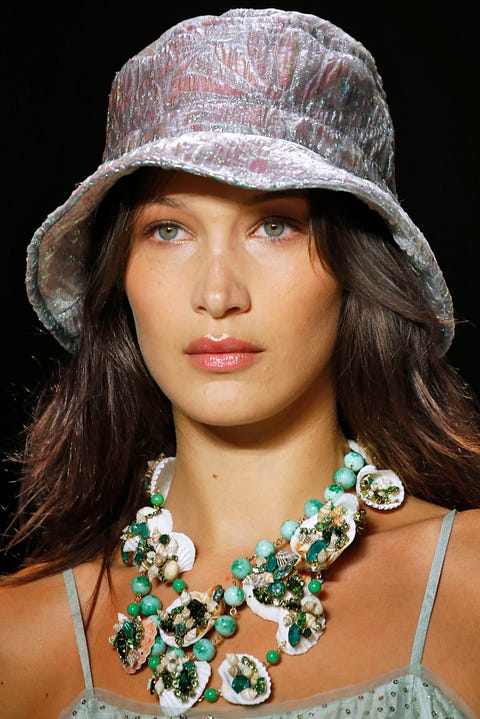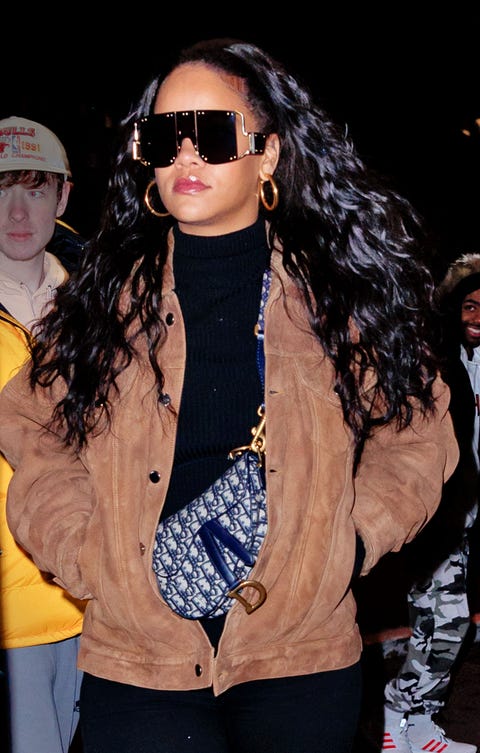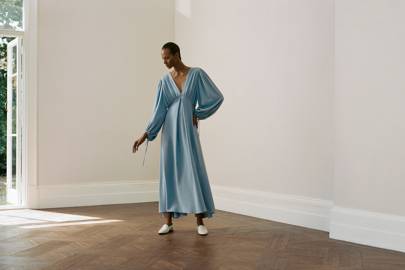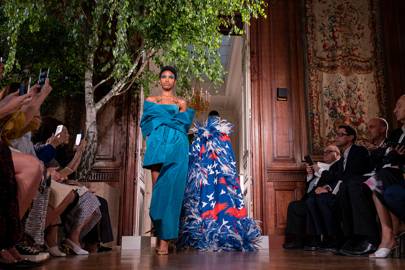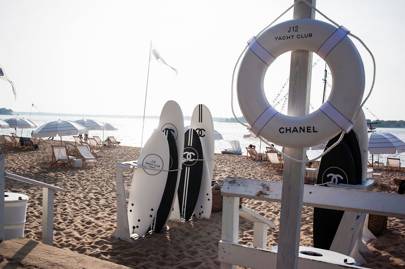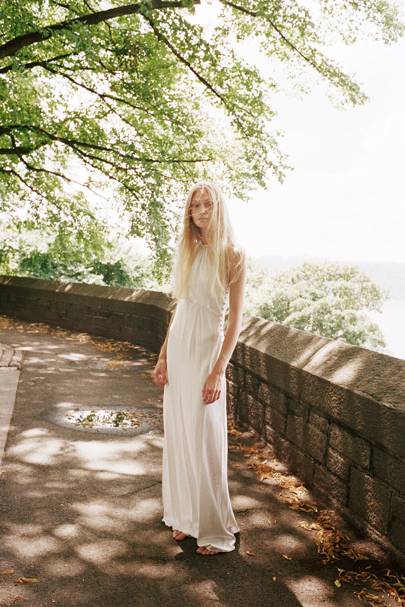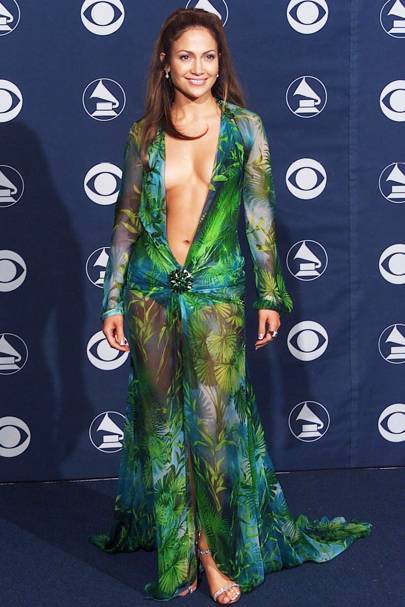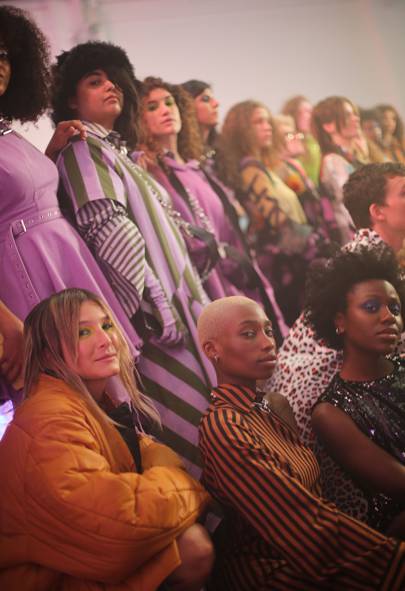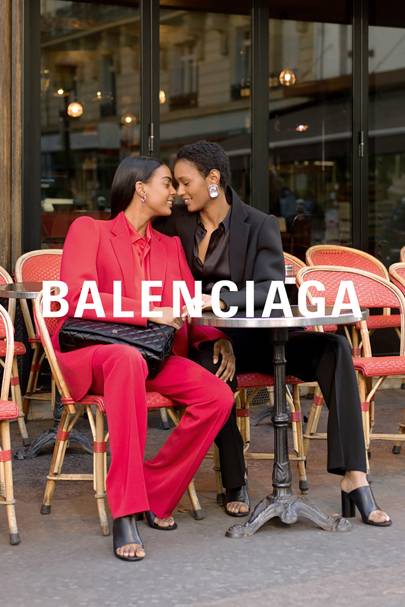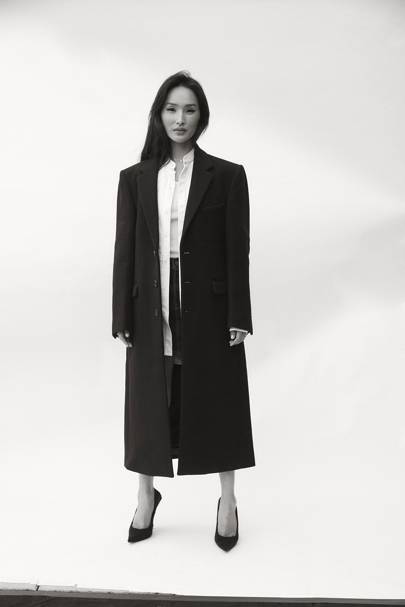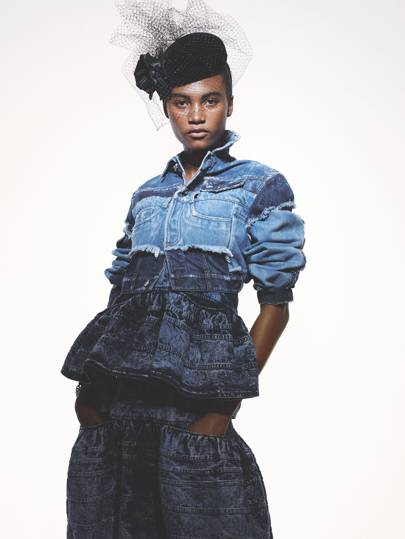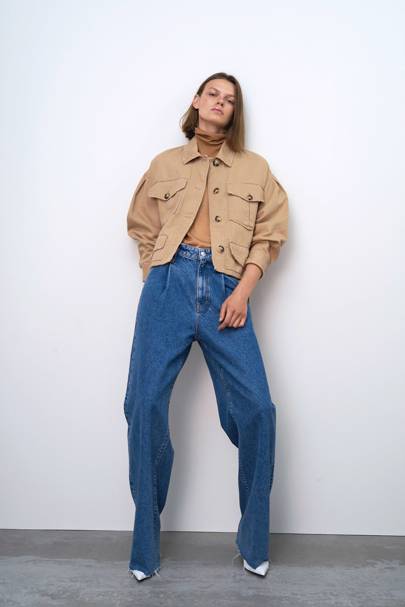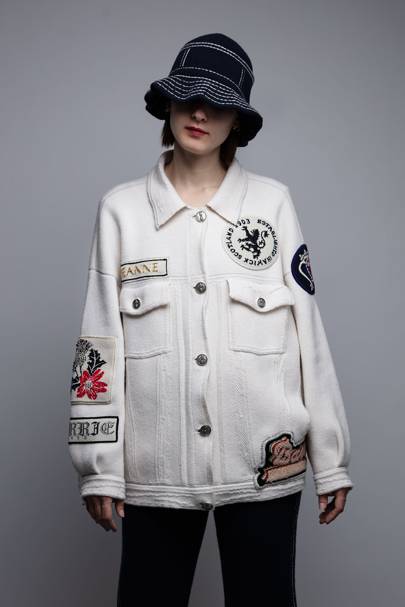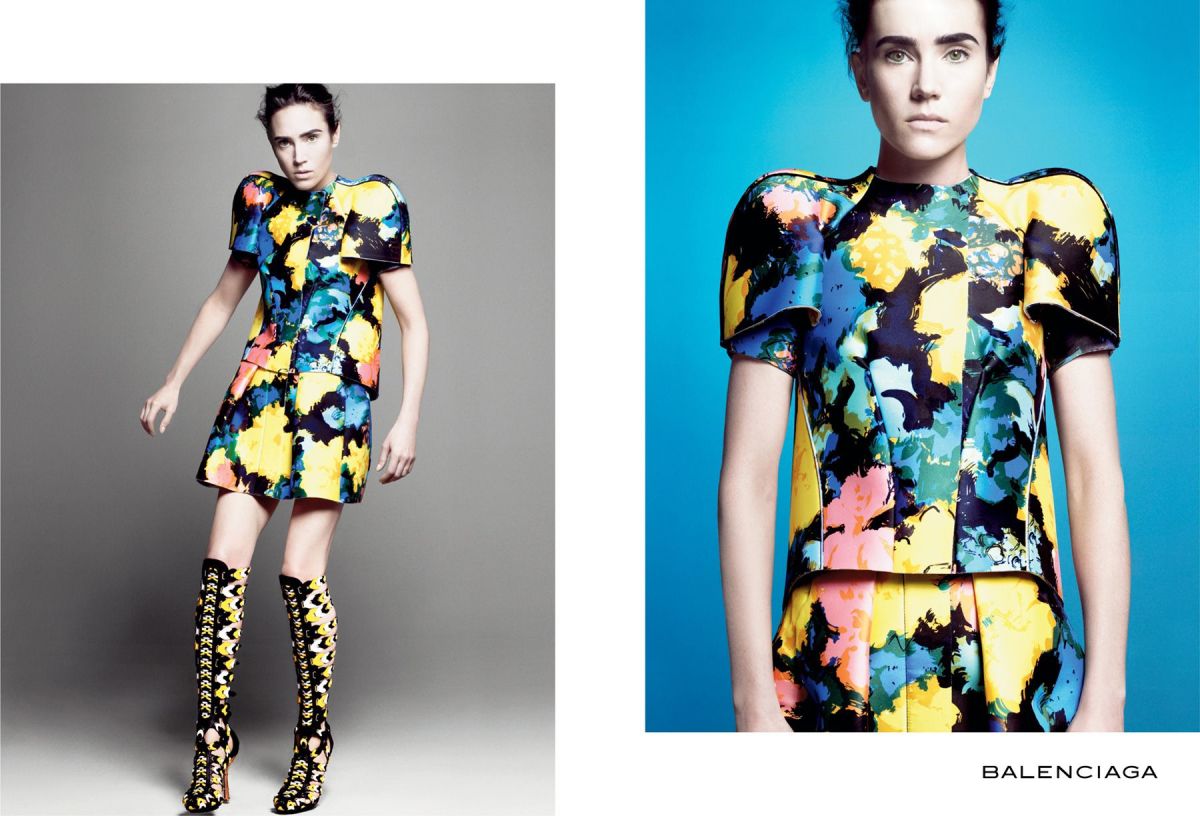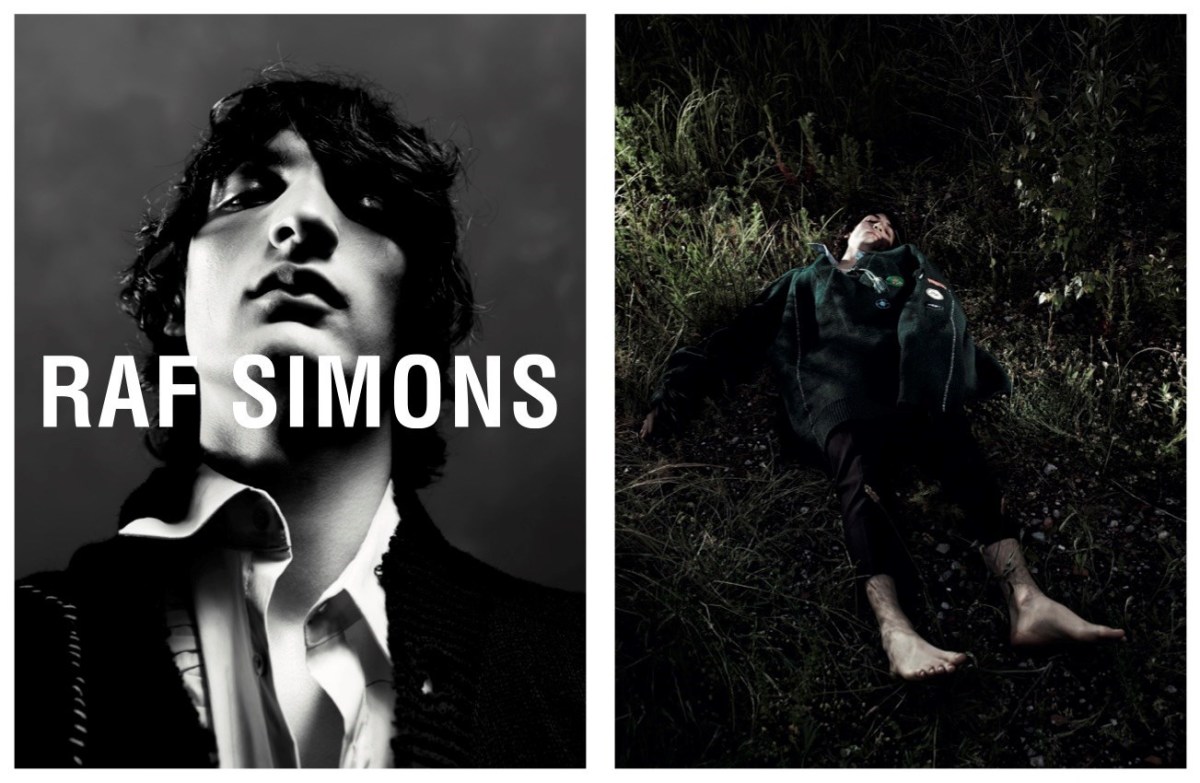The Brooklyn Museum’s Pierre Cardin retrospective explores the peaks and pinnacles of his 70-year career, but what the multimedia exhibition underscores time and again is the designer’s forward thinking.
With his 97th birthday behind him, Cardin will not be at Wednesday night’s opening party for “Pierre Cardin: Future Fashion,” as hoped. But the designer has been intrinsically involved with the planning of the exhibition, which features 19 sections — each with a well-measured mix of fashion, snapshots, videos, accessories, furniture and industrial design — set against Pop Art-ish and photographic backdrops. The show runs through Jan. 5 with leadership support provided by Chargeurs Philanthropies.
By today’s standards, “Twenty-First Century Unisex,” “Kinetic,” “Licensing,” “Democratization and Pluralization,” “New Material and The Visible Invisible,” and “A Future for Cinema” may seem like been-there-done-that. But what distinguishes Cardin from many of his contemporaries is how he raced to be the first, as indicated by the Eve Arnold-shot photo of the fashion show that Cardin staged at the Great Wall of China in 1979 — but was only recently revealed. In addition to China, Cardin was the first European designer to show in Russia and India. That sounds about right for a designer who once said, “I do not look backward but forward.”
Like many museums around the globe that are using fashion as the gateway to get patrons in the door, The Brooklyn Museum has upped its numbers thanks to shows dedicated to David Bowie, Frida Kahlo and others. A video clip from its 2014 Jean Paul Gaultier exhibition helped to set the Cardin one in motion. After learning that Gaultier worked for Cardin at one point, the curators started to look at Gaultier’s work through different eyes. That jogged such childhood memories of getting a Pierre Cardin gift set — perfume, soap-on-a-rope and that kind of thing — as well as images of broad-shouldered jackets from the Eighties. The Newport Restoration Foundation’s compact Cardin exhibition in 2017 was followed by one at the SCAD FASH Museum of Fashion + Film, which prompted Matthew Yokobosky, senior curator of fashion and material culture, to float the idea by the Brooklyn Museum’s Anne Pasternak and David Berliner. “PIERRE CARDIN YES!!!” was their e-mailed response, he said.

The curator’s favorites include the early Seventies Kinetic dresses (like the “Carwash”) that “move in ways we really haven’t seen before in fashion,” and the illuminated clothes, a concept first tested in 1968 by embroidering lights into a dress debuted by Cardin muse Maryse Gaspard. In the last gallery before the gift shop, a handful of light-infused dresses are shown opposite a monitor playing a 1963 episode of “The Jetsons” that references a “Pierre Martian” original.
Saturday’s 50th anniversary of the Apollo 11 lunar landing appears to be symbiotic, given all the Space Age-inspired fashion and memorabilia. Cardin was so enthralled that he visited NASA in 1969, and “you can see he absorbed the reality of that technology and the same thing happened later when he visited computer labs. The designer’s computer 1980 coat has fins on the back similar to ones he saw on a computer,” said Yokobosky, gesturing toward a colorful futuristic lamp as another iteration of the design.
“The clothes I prefer are the garments I invent for a lifestyle that does not yet exist, the world of tomorrow,” Cardin once said.
Gallery goers can also see color footage of Cardin’s 2008 Gobi Desert fashion show, his 2016 Yellow River Stone Forest fashion show and the 2018 Great Wall fashion show. There is a lot to be learned in the wall text, too, such as how Cardin showed his first men’s collection, the “Cylinder” line, on 250 college students in 1960 or his preference for narrating shows that could stretch beyond the 90-minute mark in the Seventies and Eighties. After one such occasion at the Met in 1980, Andy Warhol described in his diary piling into C.Z. Guest’s station wagon to attend. “It was the longest show in the world…I think he’s kept every dress that he’s ever made. I did like it because he’s kept so many dresses from 1950-1980,” Warhol wrote.

Tack on 40 more years and it’s clear that Yokobosky had an abundance of possibilities for the show. More often than not, epic is overused, but it is spot on in relation to Cardin’s multidimensional career. Over the course of his career, Cardin’s logo was stamped on more than 850 licenses. In 1969, his empire enabled him to acquire the historic Théâtre des Ambassadeurs in Paris, which has since been restored as Espace Cardin. In 1981, he bought famed bistro Maxim’s (where he once had been refused entry years before), the Palais Bulles (the Bubble House) in 1992 and later a castle in Lacoste, France, where he stages an annual music festival.
In addition to watches, clocks, radios, lighting and other categories, Cardin delved into furniture, cars and airplanes. He designed upholstery, taillights, strip detailing and other accents for the 1972 Javelin, and the interiors and exterior of the Atlantic Aviation’s Westwind 1124 (riffing on a 1967 coat design and a 1970 watch for the latter). More striking is one of Cardin’s most recent furniture designs — the Sunset Crescendo; imagine an orange sun resting on a bright blue wave.
Even more intriguing is the night sky-inspired gallery, which features a 28-foot Saturn-like ring around the room that appears to be illuminated for what is supposed to be an asteroid effect. Fifty minutes into Tuesday’s preview, the curator mentioned how he also designs his shows. The intergalactic asteroid effect required 1,400 pixels of multicolored lights that were individually programmed in blue, pink and white, and the walls are adorned with images of star fields from NASA. “He talked about how as a child, he liked to look up at the galaxy and thought, ‘That’s what evening dresses should look like,’” said Yokobosky of Cardin and gesturing toward a mint green-colored silk gown with synthetic lamé and Swarovski crystals that Naomi Campbell once wore to Buckingham Palace last year.
Traces of other VIPs can be seen in a 1967 clip of a Mia Farrow fitting and Cardin’s longtime collaborator and friend Jeanne Moreau’s 1963 trailer for “Bay of Angels.” The Cosmocorps vignette spotlights the collarless suit he designed for his Cylinder collection. Cardin also made one for The Beatles, who wore that look for a long time. “They had their own costume designer so Pierre wore the first one and the other person made the next 50 versions of it,” Yokobosky said. (French composer Jean-Michel Jarre’s music is piped through the galleries for the exhibition.)

A photograph of one of Cardin’s fans, Raquel Welch, in a black bodysuit, blue vinyl mini skirt and Plexiglass visor, graces the cover of the exhibition’s book and the film actress is expected at tonight’s opening. When the show opens to the public Saturday, ticketholders will also find a teaser for the upcoming documentary “House of Cardin,” which is expected to debut at the Venice Film Festival.
There are also such microcosms of American history as the red collared wool suit purchased by Jacqueline Kennedy in 1957 and worn three times before and during her White House years. “We have it documented that she wore it three times. The first time was to a Congressional hearing. Today we’re so obsessed that you only wear something once,” Yokobosky said. Near the encased ensemble, visitors can watch a 1957 video clip of her wearing the suit for a TV tour of her Georgetown townhouse for the show “Home.” That was also the look of choice for the Kennedys’ first official visit in 1961 to Canada, as evidenced by the Life magazine cover of her chatting with a Canadian Mountie.
Images of Hiroko Matsumoto, the model whom Cardin first met during a 1957 trip to Japan where he had been invited to teach 3-D design at Bunka Fukuso Gakuin to a class that included Hanae Mori and Kenzo Takada, are featured in one section. After writing her numerous invitations to come to Paris, she did in 1960 and later convinced to come work for him, is featured in various photos, backdrops and fashion show video clips. She is believed to have been the first Japanese model to walk on European runways. Nearby is a dog-eared, 20-page feature from a 1967 issue of Elle magazine that is Cardin’s personal copy. Other keepsakes include a black-and-white Bill Cunningham photo from the “Battle of Versailles,” the 1973 showdown between American designers and their French counterparts. The image centers on the spaceship Cardin designed for his models to step out of and onto the stage.
Decorative necklaces that doubled as functional halters, lenticular printed dresses reminiscent of holograms and 3-D molded dresses show the designer’s dexterity. With a cadre of models in tow, Cardin brought Space Age-inspired fashion on his trip to NASA’s Manned Spacecraft Center in Houston in 1969, which featured the happening in its “Roundup” newsletter. Further proof of that outing is an oversize photo of Cardin wearing what he said was Neil Armstrong’s Apollo 11 spacesuit, though there was some question that it may have belonged to Buzz Aldrin.

During a walk-through last week, Iman also gave her approval — more specifically for the designer’s recent couture eveningwear, Yokobosky said. Stopping in front of a 1990 Parabolic black velvet gown with pink and blue sequins that uses his signature lasso back on the front of the skirt, Yokobosky, said of Iman, “She came here and said, ‘This my dress.’ It was funny. She would assign a model to each dress. She would say, ‘That’s a Pat Cleveland dress.’”
One of the more consistent looks that is featured throughout the 170-item show is variation of a black bodysuits. While teaching a small group of students before a pre-Olympics fashion show in 1996 in Atlanta, Cardin told them, “’Thirty years ago when I was doing the black bodysuit, all the critics told me that it was ugly. Look at what everybody is wearing today,’” Yokobosky said.
Born in Italy, Cardin — one of 10 children — and his family fled Fascism for France. At 18, he left home and started training as a tailor. In the Forties, Cardin worked at Paquin and then Elsa Schiaparelli for a spell, before becoming Christian Dior’s first hire at his atelier. Venturing out on his own in 1950, Cardin understood construction, partially due to his adeptness at mathematics, geometry and artistry.
“His ability to think through the mathematics of construction is why he is able to absorb what was happening with the technology that he saw at NASA and the computer lab. A lot of people don’t necessarily have the skill set to be innovators,” Yokobosky said. “He’s 97 now. I was surprised how active his mind is. I can’t imagine what it was like in the 1960s and the 1970s. He has so many ideas — one after the other…During World War II, he worked for the Red Cross and he studied accounting. I said to him, ‘I think that came in very good use for you later on.’ And he told me, ‘Oh, it did.’”

Cardin grasped how a profitable licensing business would allow him to experiment with fashion, without being reliant on a bank. “He created a very open and free situation for himself. Then he bought Maxine’s, the Palais Bulles — and all these things,” Yokobosky said. “When we were having a photo taken together in Paris, I went to fix his shirt and tie a little bit. He said, ‘No, no, no. Open your shirt.’ Going home after that, I thought, ‘It’s about freedom. Be free and you’ll be more creative.”
As for making his show photo-friendly, Yokobosky said, “The accessibility of fashion, social media’s kaleidoscopic reach, consumers’ round-the-clock selfies and vanity as a virtue aren’t the only reasons that the art world is embracing fashion. Just as happenings and installation art became immersive, fashion became immersive through these big fashion shows and experiences that translated well into museum exhibitions. When you design the show, it’s not like it was 10 years ago. Every corner has to be an Instagram moment. So you have to think about that. It’s a different way of designing.”
Having forged through the decades without any outside financial investors, Cardin’s succession plan has not yet been revealed. “People internally and externally are thinking about, ‘What’s going to happen?’ I think it’s going to be a surprise. I’m sure that he has made some decisions,” Yokobosky said.

